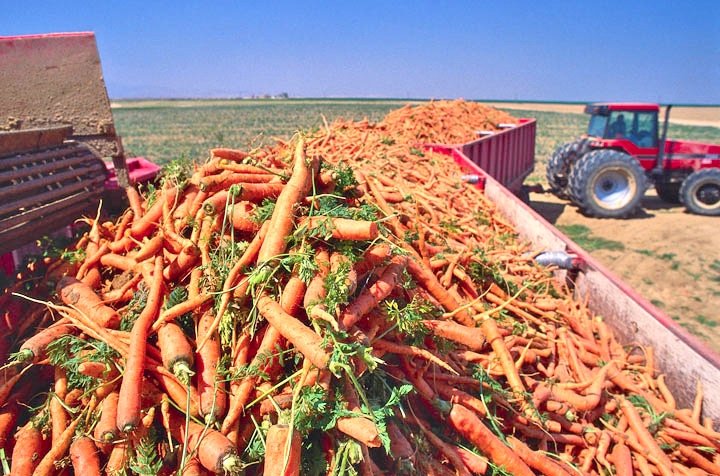
Compared with a year earlier, fall season area for harvest of 11 selected fresh-market vegetables in the U.S. is expected to rise by 5 percent this year, to 153,450 acres, according to the latest USDA Vegetable and Melons Outlook.Without the expected 5,000-acre gain in California carrots, the rise in fall fresh vegetable area would have been a more modest 2 percent.Area in California, which accounts for about two-thirds of fall vegetable acreage, is expected to rise 6 percent from a year earlier. Lower area is expected for tomatoes and head lettuce but this will be more than offset by stronger area for most other vegetables including carrots, broccoli, sweet corn, celery and cauliflower.
January 9, 2012

Compared with a year earlier, fall season area for harvest of 11 selected fresh-market vegetables in the U.S. is expected to rise by 5 percent this year, to 153,450 acres, according to the latest USDA Vegetable and Melons Outlook.
Regional shipments from late summer/early fall crops began to wind down in mid-October, with ample volume keeping downward pressure on grower prices for most fresh-market vegetables.
As shipping seasons came to a close in states such as Michigan, New York, Ohio and Pennsylvania, the supply focus shifted to states such as California, Florida, Georgia, Texas and New Jersey.
Although grower prices going into the fall were generally low-to-average at best this year, most planting decisions were made months in advance, with current market conditions holding limited sway over area for the coming season.
The size of the increase in fall acreage (primarily October-December) may be a bit misleading as the majority of the gain in area this fall was concentrated in a projected 30 percent surge in carrot acreage. Without the expected 5,000-acre gain in California carrots, the rise in fall fresh vegetable area would have been a more modest 2 percent.
Fall fresh-market vegetable acreage in California (up 6 percent), Florida (up 2 percent), and Georgia (up 3 percent) increased from a year earlier. Most of the gain in Florida was concentrated in cabbage and sweet corn, which both experienced above average prices this past summer.
Area in California, which accounts for about two-thirds of fall vegetable acreage, is expected to rise 6 percent from a year earlier. Lower area is expected for tomatoes and head lettuce but this will be more than offset by stronger area for most other vegetables including carrots, broccoli, sweet corn, celery and cauliflower.
Top five vegetables
This fall, the top five fresh vegetables in terms of market volume (excluding potatoes and onions) are expected to be head lettuce, carrots, celery, tomatoes and broccoli. Head lettuce area is down 4 percent with average yields expected this fall.
After a difficult winter featuring weather-driven high prices, June-October grower prices for head lettuce averaged below a year earlier and the average of the three previous years. A consistently cool California summer favoring good yields, competition from locally grown greens, and sluggish consumer demand kept downward price pressure on the California head lettuce market all summer.
With regional suppliers finished for the year, smaller fall area in prospect, transitions from coastal to inland growing areas, and the ever-present threat of unsettled fall weather, grower prices for head lettuce may turn higher from their summer seasonal lows.
However, given average yields and continued tepid consumer demand, fall head lettuce prices are expected to remain below those of a year earlier.
Spurred in part by lower prices last fall, fall tomato area is expected to drop 2 percent to 18,000 acres. Preliminary data indicate that harvested area in Florida is expected to remain steady, while acreage in California is expected to account for the entire 300-acre reduction.
Part of the drop in U.S tomato area likely will be offset by improved yields since there have been few weather extremes (cooler in California and minimal tropical storm activity in western Florida) during the fall growing period.
Florida’s fall tomato area continues to be eroded by lower-cost supplies from California and Mexico and strong retail competition with hothouse tomatoes.
Florida expects to harvest just 6,000 acres of fall tomatoes compared with a recent peak of 17,100 acres in 1999. Fresh-tomato movement increased this past summer largely on the strength of rising volume from greenhouse-grown products such as imported roma tomatoes from Mexico.
The winter outlook is largely dependent on whether freezing temperatures are felt in production areas for a third consecutive winter.
Assuming no extended periods of below-freezing temperatures reach Florida, the desert southwest, or western Mexico, greatly improved supplies will bring a substantial reduction (25 percent or more) in fresh-vegetable prices this winter.
About the Author(s)
You May Also Like



